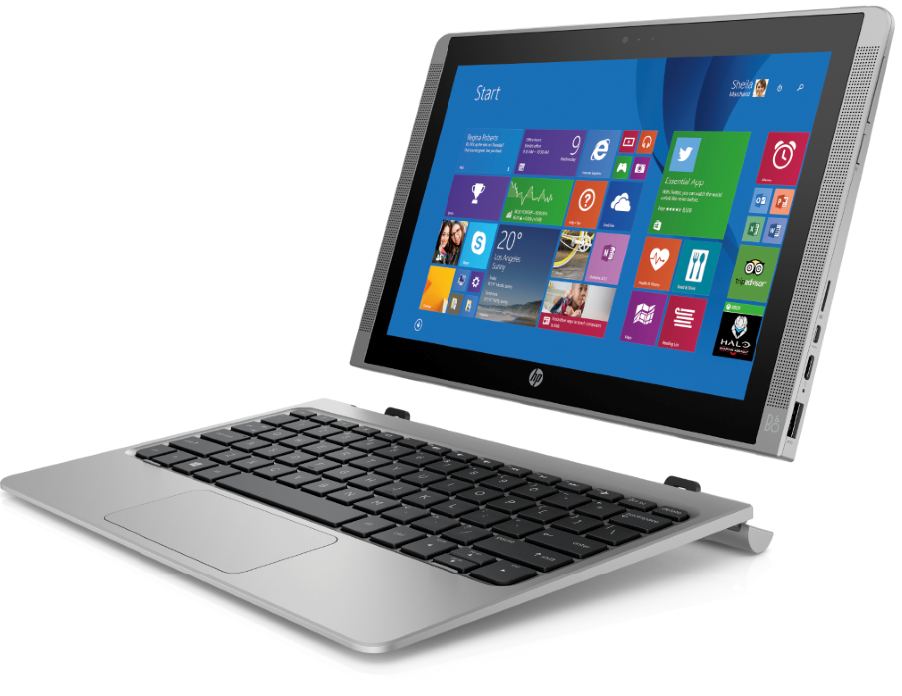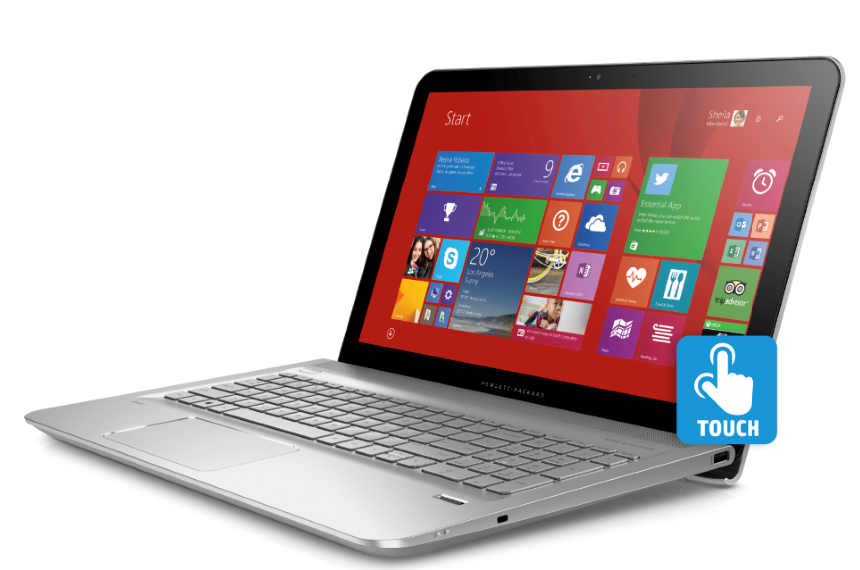HP Refreshes Envy Notebook Lineup, Includes 15-Inch Carrizo Model
HP announced its 2015 lineup of Envy notebooks, which now have a curved design and lighter construction. The company also revealed a new Pavilion with a detachable keyboard.
Among the notable features of the new lineup is the presence of a USB Type-C connector on the Pavilion x2 and an AMD Carrizo option on the 15.6-inch version of the Envy. We're just (finally) starting to see more USB Type-C connectors on new devices, but unfortunately, the port on the x2 only offers USB 2.0 data speeds. (Why, oh why, would HP not implement USB 3.1 here?)
Regarding the Carrizo-based Envy option, there are many configurations, but the starting price is listed (see more at the bottom of this article) at $629. That's nudging awfully close to the edge of that promised $400-$700 Carrizo notebook range. In any case, the HP Envy 15 is one of the very first Carrizo-based notebooks that's been given full specs, pricing, and availability.
HP Pavilion x2
The HP Pavilion x2 will be available in three different colors: Blizzard White, Sunset Red and Turbo Silver. It will feature a 10-inch IPS display and a latch-free magnetic connector for the detachable keyboard, which HP said is nearly full-size.
The Pavilion x2 makes use of a quad-core Intel Atom processor and includes 64 GB of internal storage, which can be expanded with an SD card. The device is charged through a USB Type-C port that doubles as the power port, and it offers USB 2.0 data transfer. A standard USB 2.0 port can also be found, along with a Micro HDMI port for external displays. On the front of the x2 are two speakers and an HP TruVision webcam. Battery size was not specified, but HP did claim that it managed 10.75 hrs of continuous HD video playback during internal testing.
The device will be quite light and thin. With the keyboard attached, it weighs 2.48 lbs and is 16.75 mm thick. Without the keyboard, the weight is reduced to 1.29 lbs with a thickness of 9.65 mm.
Envy Notebooks
Along with the Pavilion x2, HP launched a new lineup of Envy notebooks for 2015. The series included three different sizes with varying options.
Get Tom's Hardware's best news and in-depth reviews, straight to your inbox.
14-inch
The 14-inch notebooks are available with Intel i5 and i7 processors and up to 16 GB of memory, and they feature HD and Full HD display options. Storage choices include mechanical, hybrid and SSD drives, with capacities reaching 2 TB. There are three USB 3.0 ports located on one side.
This version of the Envy notebook weighs 4.25 lbs and includes a 55.5 watt-hour prismatic battery. HP claimed that battery life is as long as 10.25 hrs with this model.
15-inch (with a Carrizo option!)
The 15.6-inch Envy offers a plethora of options. In addition to the same Intel processor choices, this size offers AMD FX and A10 "Carrizo" APUs in addition to the option of adding discrete graphics. Nvidia GeForce GTX 940M and 950M GPUs are available, as are some R6 and R7 options from AMD.
For these models the choices get a little bit confusing. Intel-based systems can have hard drives as large as 2 TB, and up to 16 GB of memory. AMD-based systems are limited to 1 TB of hard drive space, and only 8 GB of RAM. Both processors allow for mechanical, hybrid or SSD options.
The display options vary for this model as well. HD, Full HD and Quad HD+ panels are available for Intel-based systems, and each size has the option of touch sensitivity. AMD-based notebooks are limited to HD display, but they also offer touch as an option.
AMD-based models will have three USB 3.0 ports along with one USB 2.0 port. Intel-based machines will have four USB 3.0 ports and have an option for an optical drive.
All models of the 15.6-inch Envy will include 55.5 watt-hour prismatic batteries that HP has claimed offer up to 9.5 hours of continuous use. Each one weighs 5.03 Lbs.
17-inch
HP is positioning the 17.3-inch version of the Envy as a notebook for video editing and mobile gaming. This size will only be available with Intel i5 and i7 processors and will feature discrete graphics options of GTX 940M and 950M GPUs. The IPS display is limited to Full HD, but again HP offers the choices of touch or no touch.
The larger laptop has the option for an additional drive, bringing the maximum total capacity to 4 TB. It has the same options for mechanical, hybrid and SSD drives available, and it also includes four USB 3.0 ports, a full-sized HDMI port, and an RJ45 network jack. It also has an option to add a DVD or Blu-ray drive.
Despite the size, the 17-inch model doesn't weigh much more than the other Envy systems. It tops the scales at 6.22 lbs, even with the larger 62 watt-hour battery, which HP claimed should be good for 10 hours of use.
The whole lineup of Envy notebooks shares a number of features. All versions include an LED-backlit keyboard, though the larger 15- and 17-inch models include a numpad. Each model includes Bang & Olufsen speakers and a subwoofer. Intel-based machines have four speakers, while AMD systems have two, and they all share the same noise-cancelling dual-array microphone. They also each feature an offset hinge that doubles as a bit of a stand. HP said this allows for better airflow under the device, and for a more comfortable typing and viewing position.
HP Pavilion x2 convertibles will be available July 21 starting at $299. Envy notebooks are expected in July on HP's website, while some 17-inch models will be at Best Buy July 5, and 15-inch versions by August 30. The models will vary in price, with the 14-inch model starting at $699, 15-inch AMD models as low as $629, and $799 for 15-inch Intel systems. The 17-inch models will start at $999.
Follow us @tomshardware, on Facebook and on Google+.
Kevin Carbotte is a contributing writer for Tom's Hardware who primarily covers VR and AR hardware. He has been writing for us for more than four years.
-
Hando567 The Carrizo option would be more exciting if they didn't totally cripple everything around it. A 15" 1366x768 (who came up with that anyway?) screen is NOT acceptable in 2015. Seriously, how much more expensive would a 1080P panel have been? They pretty much give those things away these days.Reply
Then to top it off they omit any SSD option and instead include a 5400 RPM drive standard. Again, this is no longer an OK thing to have for a boot drive in 2015. Sure this could probably be changed yourself later, but why not offer it as a factory option? -
Shankovich How many times does AMD need to tell you that Carrizo chip is for a 1080p screen. Do engineers even make decisions for you guys??Reply -
captaincharisma i still mourn the loss of voodoo. HP didn't keep them around like dell did with alienwareReply -
sullivang Reply
Heck I'd even take 1920x1200, like they used to make over 10 years ago.Still waiting for a 3K+ res laptop.
I meant 3K+ 17". -
Nintendork Really AMD, dont you realize OEM's don't give a single damn about your product?Reply
Carrizo as an option crippled in hard drive, memory or worse sh*tty TN HD panel, so AMD gets the worst of the worst.
PLEASE AMD:
Do the smart thing and release your products under your own brand, how about using the moniker Fury as a Desktop/Laptop/Tablet brand?
Was planning to get a Carrizo Envy laptop now with this pathetic quality product I probably go with an Ipad Air 2 or the Galaxy Tab S2.
768p IN 2015 IS NOT ACCEPTABLE. -
SteelCity1981 the avg person prob has never even heard of usb 3.1 and the avg person prob doesn't look for how many pixels are on a screen all they see is how big it is and that's good enough for them. So companies like hp. dell, Lenovo, Acer etc will continue to put out these products as is.Reply -
Reepca I can think of no technical reason for the limitations on AMD-based notebooks. This is absurd. The best you can get with intel is a 2TB HDD + SSD, QHD+ screen, and 16 GB RAM. The best you can get with AMD is a 1TB HDD, 768p screen, and 8 GB RAM. I could live with 8GB RAM and get by with just a slow old hard drive, but refusing access to remotely good screens just because Intel probably gave them a nice chunk of cash? This is bull crap! It's blatantly trying to put AMD farther behind. Surely there must be some sort of law against this monopolistic crap?Reply

